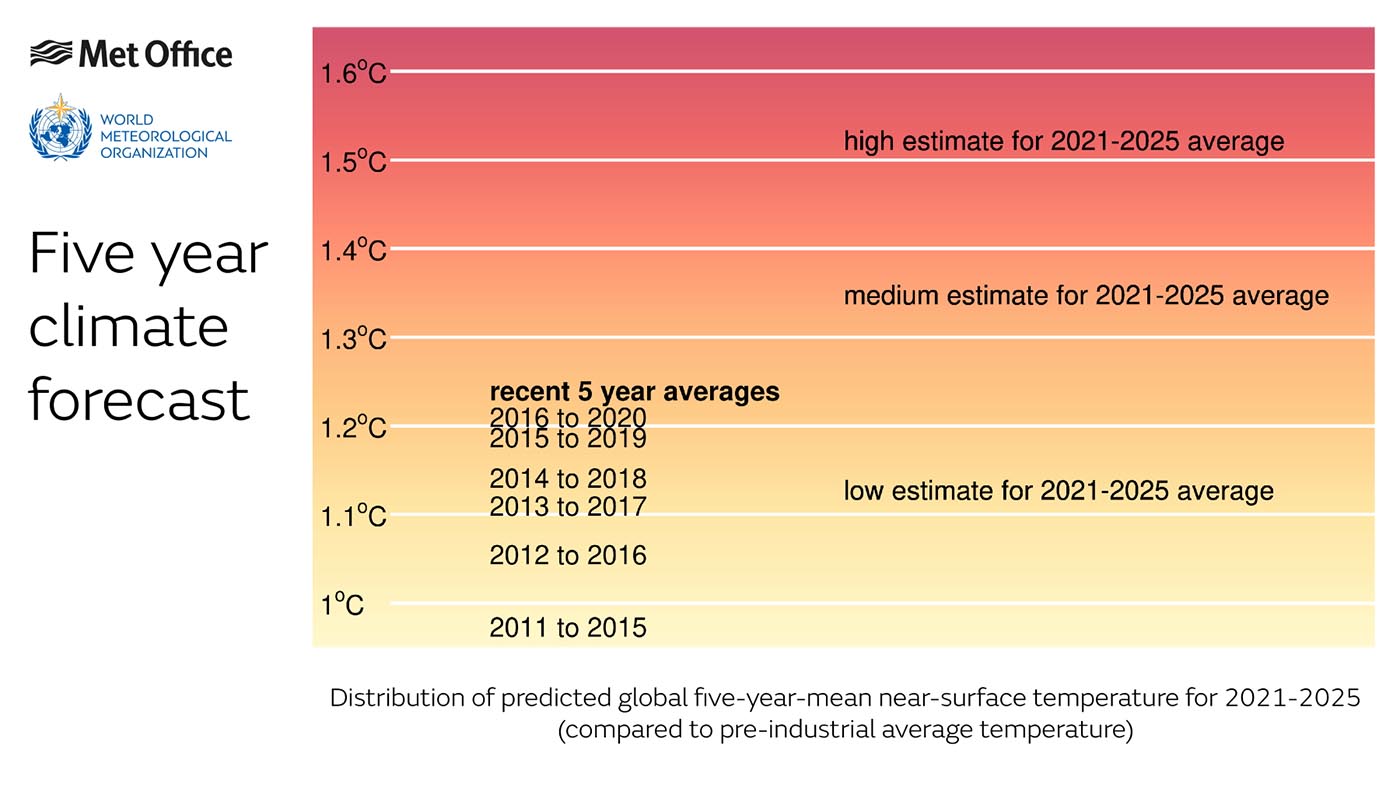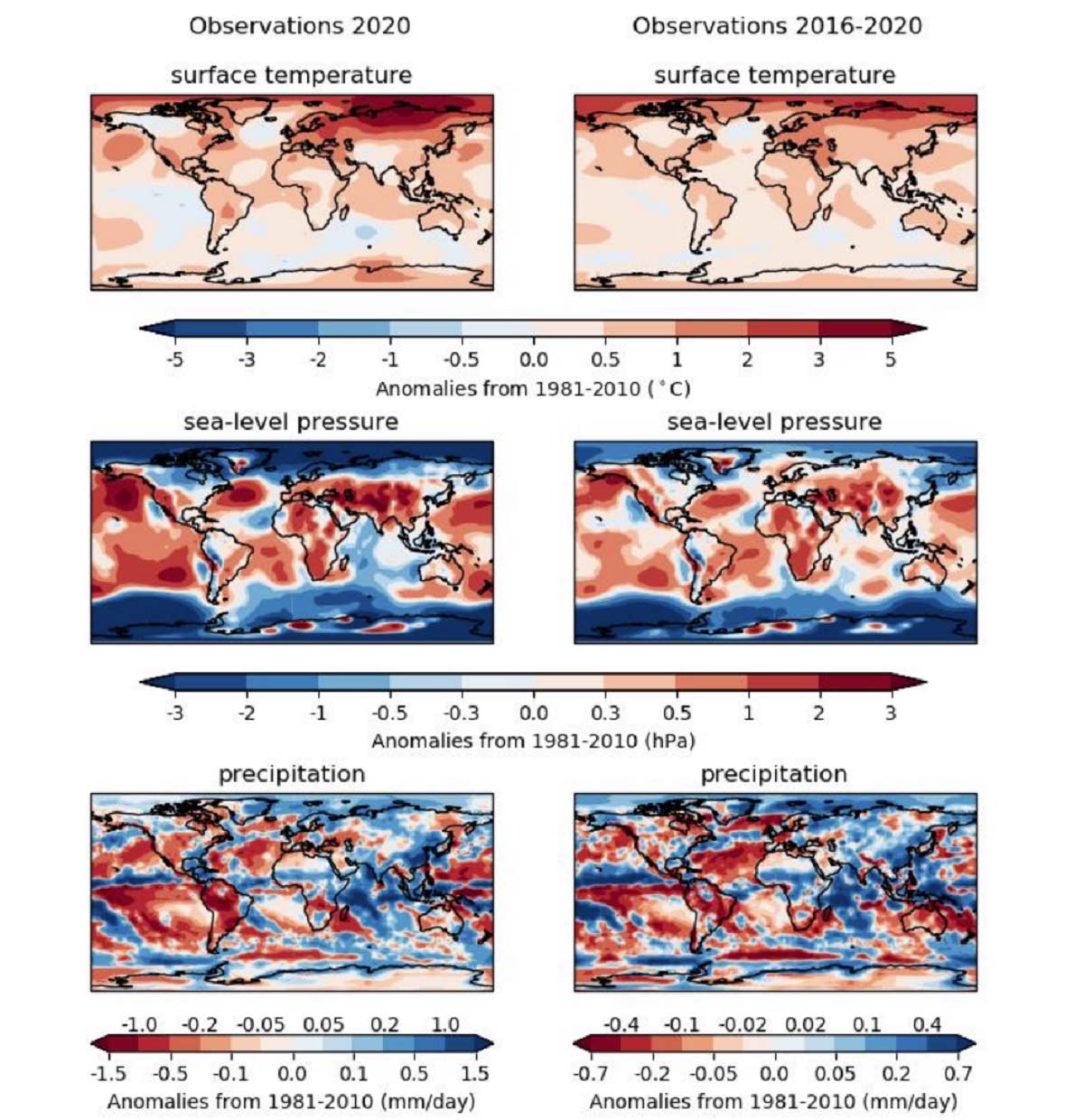Last year, 2020, the global average surface temperature was the warmest on record. But it could get even warmer until 2025. According to the latest study by the World Meteorological Organization (WMO), Earth’s average temperature will likely reach its tipping point in climate change. The anomaly of +1.5 °C is likely in the next 5 years.
2020 had the globally averaged temperature of 1.02 °C (1.84 °F) warmer than the baseline 1951-1980 mean, according to scientists at NASA’s Goddard Institute for Space Studies (GISS) in New York. 2020 edged out 2016 by a very small amount, within the margin of error of the analysis, making the years effectively tied for the warmest year on record.
But now, there is a 90 % likelihood that at least one of the next five years, including 2021, becoming the warmest on record. The high-latitude regions and the Sahel* are likely to be wetter than normal, as well tropical cyclone activity is very likely to be increased compared to the recent past (the period between 1981 and 2010).
*Note: The Sahel is the ecoclimatic and biogeographic realm of transition in Africa between the Sahara to the north and the Sudanian savanna to the south. Having a semi-arid climate, it stretches across the south-central latitudes of Northern Africa between the Atlantic Ocean and the Red Sea.

Above: Distribution of predicted global 5-year mean near-surface temperature for 2021-2025 period, compared to the pre-industrial global average temperature
The UN Intergovernmental Panel on Climate Change (IPCC) has identified the 1.5 °C markers as a tipping point after the hazardous weather as the extreme drought, wildfires, floods with more torrential rain and intense tropical systems will significantly increase.
“But these are more than just statistics”, said the WMO Secretary-General Prof. Petteri Taalas. “The increasing temperatures mean more melting ice, higher sea levels, more heatwaves, and other extreme weather, and greater impacts on food security, health, the environment, and sustainable development,” Taalas said.
Above video: Global warming between 1880 and 2020. The Earth’s global average surface temperature in the last year (2020) tied with 2016 as the warmest year on record, according to an analysis by NASA. This video is shown in Celsius degrees.
STRONG ANOMALIES IN THE RECENT YEARS
By 2020, most regions were warmer than in the recent past. Warming was largest at high latitudes in the Northern Hemisphere, especially the Arctic, and generally larger over land than the ocean, especially for the five-year mean 2016-2020. Parts of the Southern Ocean and the northern North Atlantic were cooler than in the recent past.

Above: The climate over the last year and last five years as anomalies with respect to the recent period 1981-2010.
In the last five years, sea-level pressure was anomalously low in both polar regions, with the strongest negative anomalies over Antarctica. Hence both the Arctic and Antarctic Oscillations have been positive on average.
Parts of Eurasia, the eastern USA, and the African Sahel have been anomalously wet, with southern Africa, eastern Australia, north-east Brazil, and western Europe anomalously dry in the period between 2016 and 2020.
EARTH IS APPROACHING ITS CLIMATE CHANGE TIPPING POINT
“This study is yet another wake-up call that the world needs to fast-track commitments to slash greenhouse gas emissions and achieve carbon neutrality,” said Prof. Taalas.
Last year was one of the three warmest years on record, with the global average temperature well above the pre-industrial baseline, according to the WMO’s report released in April. The report highlighted the acceleration in climate change indicators like rising sea levels, melting sea ice, and extreme weather. As well as worsening impacts on socio-economic development.
The chart below is showing the change in global surface temperature relative to the 1951-1980 period average temperatures. Nineteen of the warmest years have occurred since 2000, with the exception of 1998. The year 2020 tied with 2016 for the warmest year on record since record-keeping began in 1880. Image is provided by NASA/GISS.

And the chance of temporarily reaching 1.5°C above average has roughly doubled compared to the predictions made last year. The main reason behind it is the use of an improved temperature dataset to estimate the baseline rather than sudden changes in climate indicators.
The head of seasonal to decadal prediction at the Met Office, professor Adam Scaife, has commented on the update: “Assessing the increase in global temperature in the context of climate change refers to the long-term global average temperature, not to the averages for individual years or months. Nevertheless, a temporary exceedance of the 1.5-degree level may already be seen in the next few years.”
United Kingdom’s Met Office as lead center, was also contributed with climate prediction groups from Spain, Germany, Canada, China, USA, Japan, Australia, Sweden, Norway, and Denmark. The combining forecasts from various climate prediction centers worldwide enables a higher quality product than what can be obtained from any single source.
SUMMARY POINTS OF THE STUDY
Here are some quick summary facts the climate change recent study finds;
- The annual mean global (both the land and sea) mean near-surface temperature is likely to be at least 1°C warmer than pre-industrial levels in each of the coming 5 years and is very likely to be within the range 0.9 – 1.8°C. The pre-industrial levels are defined as the average over the years from 1850 to 1900.
- There is a 40 % chance that at least one of the next 5 years will be 1.5°C warmer than pre-industrial levels and the chance is increasing with time. And at the same time, it is very unlikely (only about a 10% chance) that the five-year mean global near-surface temperature for the 2021 to 2025 period will be 1.5°C warmer than pre-industrial levels.

Above: Next 5-year predictions by various climate change groups
- While 2016 and 2020 are the warmest on record until now – both stand at 1.02 °C above the average, there is a 90 % chance of at least one year exceeding these records over the next five years.
- Almost all regions, except parts of the southern oceans and the North Atlantic, are likely to be warmer than the recent past (defined as the 1981-2010 average) over the next five years. The high latitude regions and the Sahel are likely to be wetter than in the recent past.
- With the fastly approaching Atlantic hurricane season 2021, there is also an increased chance of more tropical cyclone formations in the Atlantic over the next five years, compared to the recent past.
- This year, in 2021, large land areas in the Northern Hemisphere are likely to be over 0.8°C warmer than in the recent past. The Arctic region (north of 60 °N) is likely to have warmed by more than twice as much as the global mean compared to the recent past. Southwestern North America is likely to be drier whereas the Sahel region and Australia are likely to be wetter than in the recent past.
You can read more details in the study below:
See also:
The world’s largest iceberg broke off Antarctica’s Renn Ice Shelf.